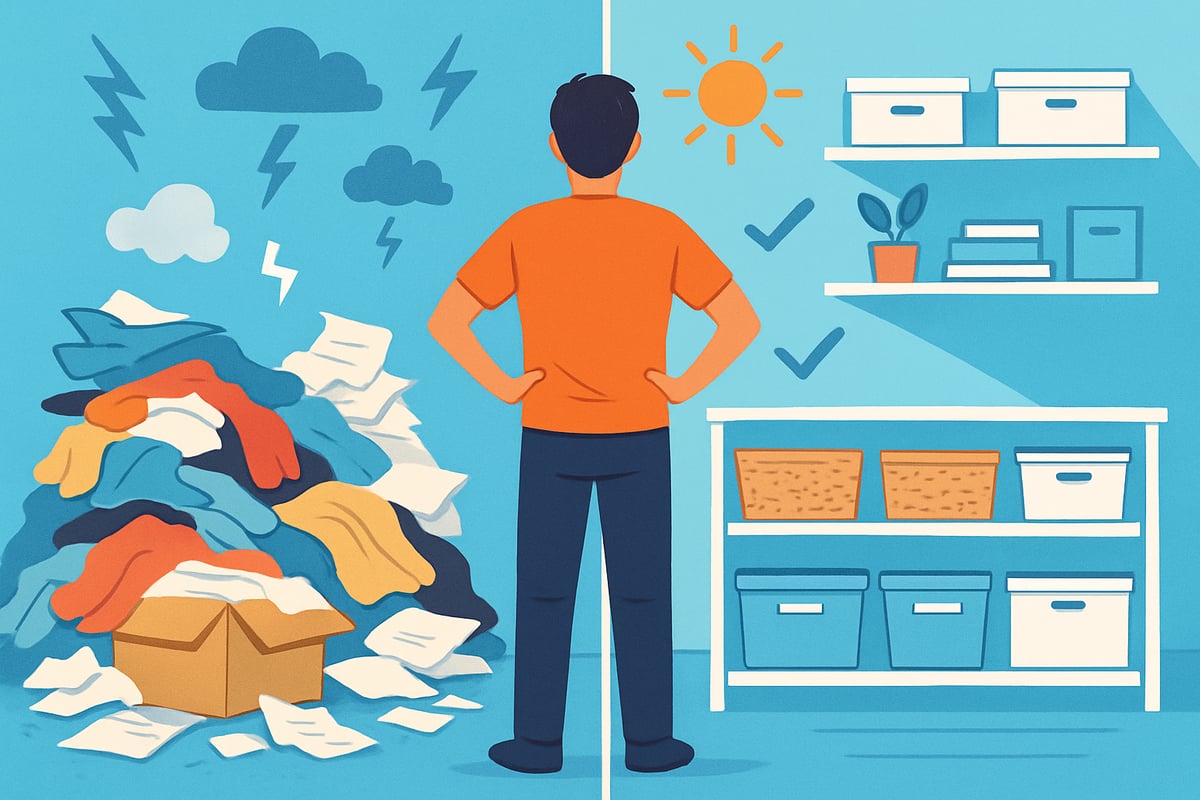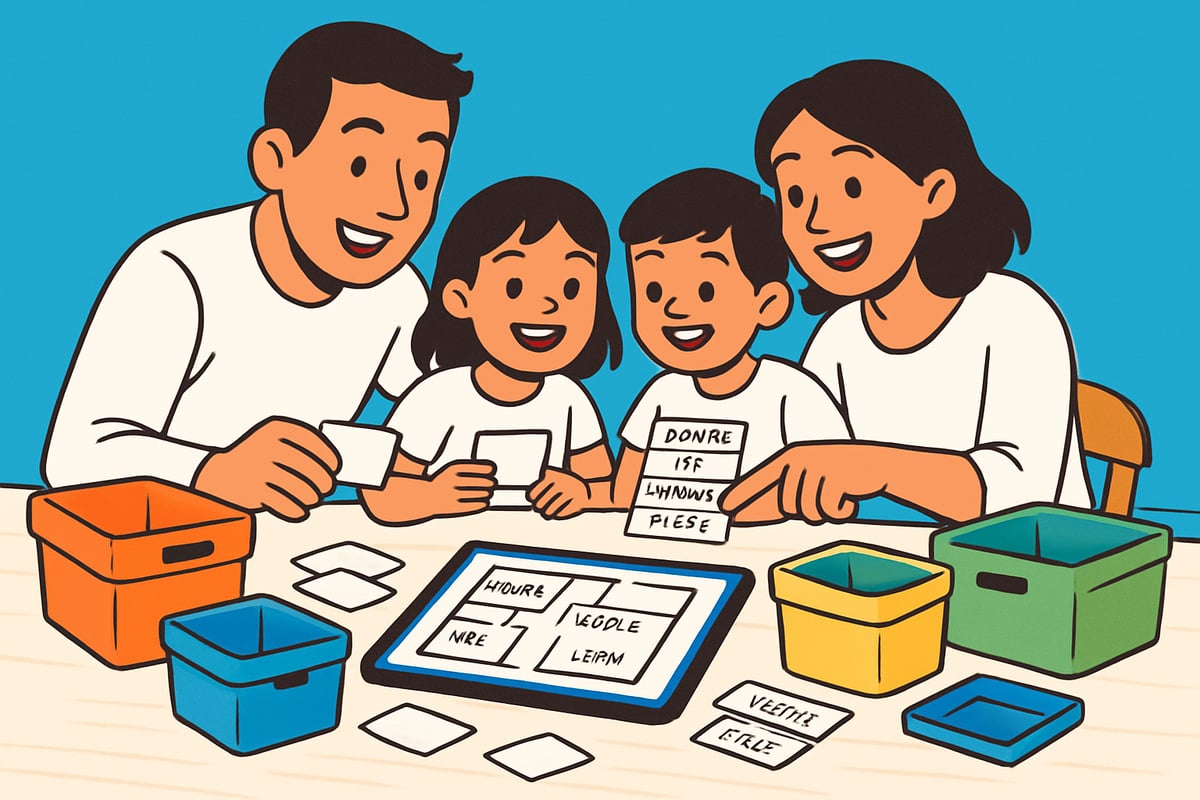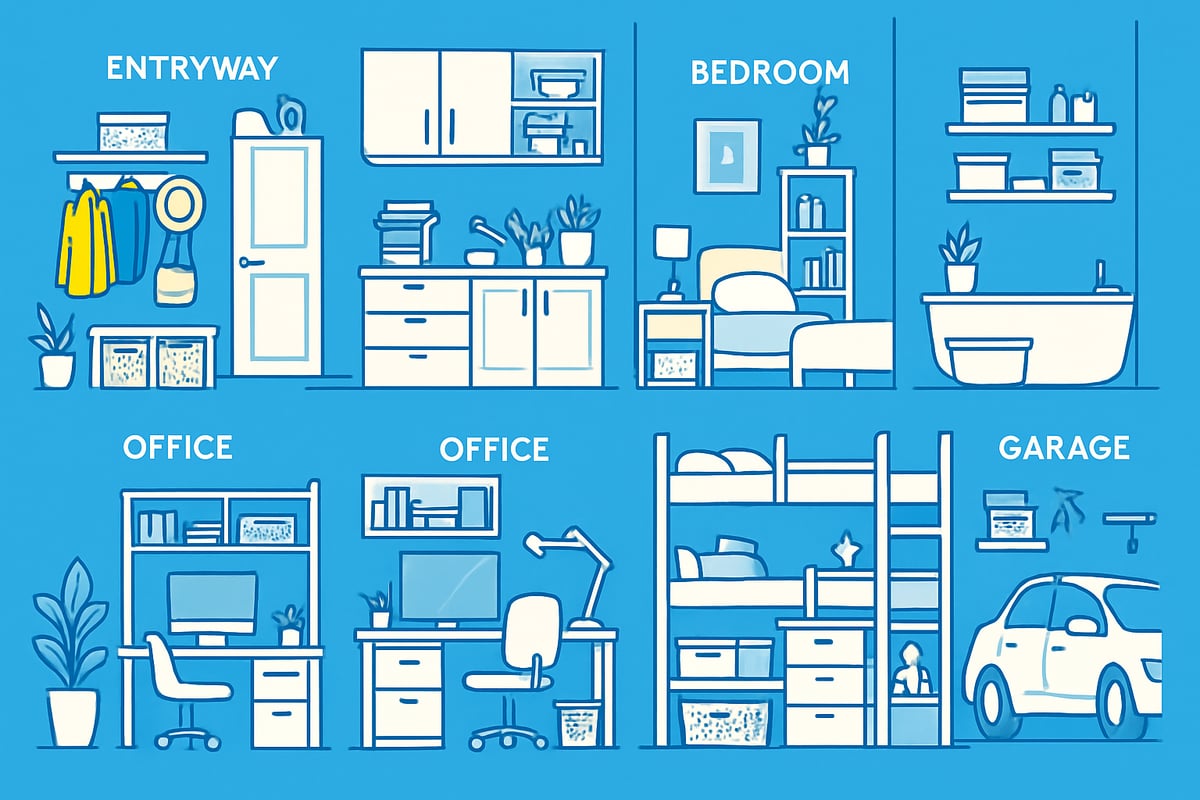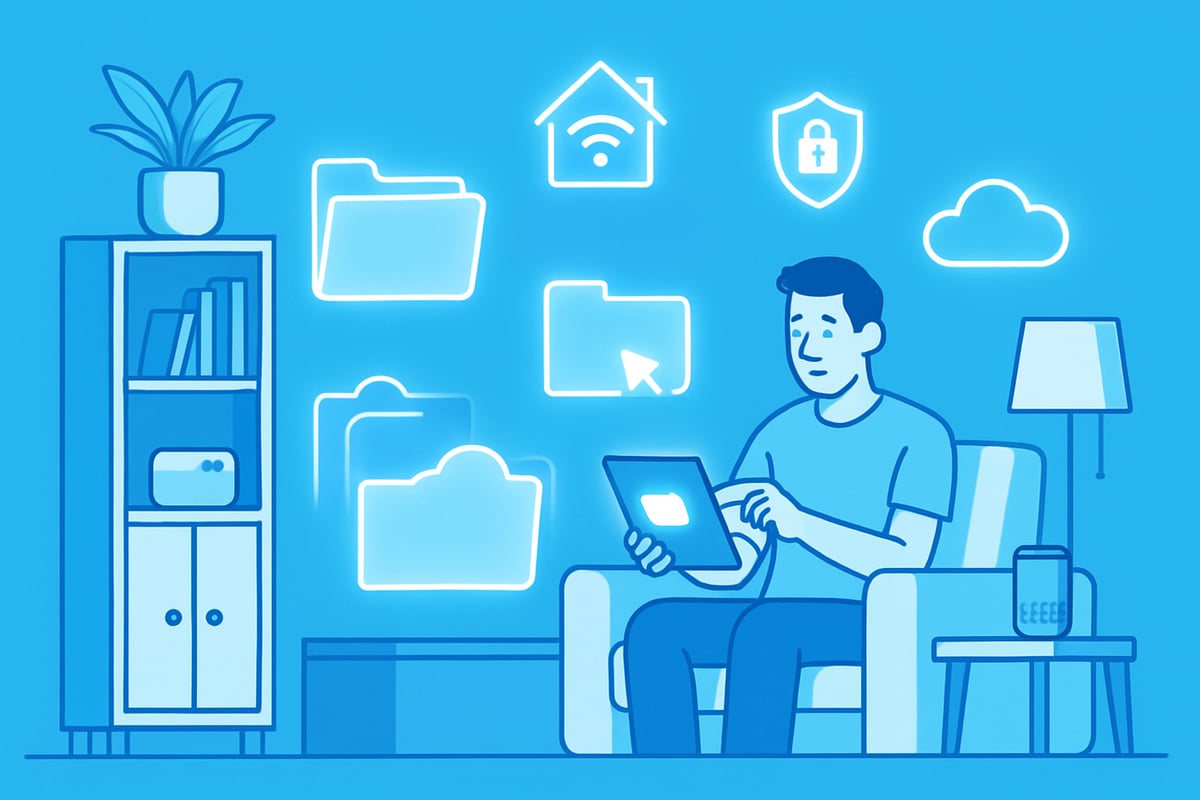Imagine stepping into your home and immediately knowing where every item belongs, from your favorite sweater to important paperwork. If you have ever felt overwhelmed by clutter or unsure where to start, you are not alone. This guide is designed to help you organize my home with proven strategies and fresh ideas tailored for 2025. We will explore why clutter happens, how to create a personalized plan, and offer step-by-step solutions for each room. By following this roadmap, you will discover a new sense of peace, efficiency, and control in your daily life. Ready to begin your transformation?
Understanding the Psychology of Clutter and Organization
Imagine you decide to organize my home, but quickly feel stuck before you even start. Why is it so hard to part with things, and what makes clutter so persistent? Understanding the emotional and psychological roots of disorganization is the first step toward lasting change.

Why Clutter Happens: Common Causes and Triggers
Emotional ties to belongings are one of the biggest reasons people struggle to organize my home. Items often serve as reminders of cherished memories, making it difficult to let go even when they no longer serve a practical purpose. Life transitions like moving, marriage, having children, or inheriting possessions can quickly fill spaces with extra stuff.
Consumer culture also plays a major role. The urge to buy new things—combined with sales and advertising—leads to impulse purchases. Over time, homes fill up faster than we realize. Procrastination and decision fatigue then set in, making it tough to decide what stays and what goes.
Consider this: Americans spend an average of 2.5 days each year searching for lost items. The sentimental value attached to objects and the fear of needing something later can keep clutter lingering. Recognizing these personal triggers is essential if you want to organize my home for good.
Here's a quick look at common clutter triggers:
| Trigger | Example Scenario |
|---|---|
| Emotional Attachment | Keeping childhood artwork |
| Life Transitions | Inheriting a relative's items |
| Consumer Culture | Buying on impulse |
| Procrastination | Delaying sorting mail |
| Sentimental Value | Saving gifts from friends |
| Fear of Future Need | Holding onto spare cables |
For more on how clutter impacts mental health and daily life, you might find the Clutter and Mental Health Study helpful.
The Benefits of an Organized Home: Beyond Aesthetics
When you organize my home, you gain much more than just a tidy space. Studies show that reducing clutter lowers stress and improves mental well-being. An organized environment helps you focus, saves you time, and boosts productivity. Imagine finding your keys or that important document in seconds, not minutes.
Financial benefits also emerge: you avoid buying duplicates and pay bills on time. For households with children or seniors, a clutter-free home is much safer, reducing the risk of trips and falls. Hosting guests becomes easier and more enjoyable when every area looks inviting.
Consider these statistics:
- 54% of Americans feel overwhelmed by clutter.
- 78% have no clear idea how to tackle it.
Real families have transformed their routines by choosing to organize my home step by step. They reclaim lost time, rediscover their favorite spaces, and enjoy a sense of peace. The journey to organization is not just about neat shelves—it’s about creating a sanctuary where you can thrive.
Preparing for Your Home Organization Journey
Getting ready to organize my home starts with a strong foundation. Before diving into boxes and bins, take time to plan your approach. By setting clear goals, gathering the right supplies, and mapping out a custom plan, you can transform overwhelm into confidence and turn chaos into order.

Setting Realistic Goals and Priorities
The first step as you organize my home is to assess your current situation. Walk through each room and take note of clutter hotspots. Identify high-impact areas, such as the kitchen, entryway, or closets, which often set the tone for the rest of the house.
Set SMART goals (Specific, Measurable, Achievable, Relevant, Time-bound) to create structure and accountability. For example, instead of saying "organize my home," try "sort and donate unused clothes from the bedroom closet by next Saturday." Breaking big projects into smaller, manageable tasks, like focusing on one room per week, makes the process less daunting and more sustainable.
Remember, clear goals not only help you track progress, but also prevent overwhelm. By understanding where to start and what to prioritize, you’ll feel motivated and empowered to keep moving forward.
Gathering Supplies and Tools for Success
To organize my home efficiently, gather essential tools before you begin. Stock up on storage bins, labels, shelving, and donation boxes. These basics will help sort and contain items as you work through each space. Digital tools are just as important—consider home inventory apps and task management apps to streamline your process.
If you’re keen on sustainability, repurpose containers you already own or choose eco-friendly products. Budget-conscious? Compare the cost of hiring a professional organizer with a DIY approach, and decide what works best for your needs. Sometimes, investing in the right tools saves time and frustration down the road.
A practical addition to your toolkit is a home organization binder. These binders keep checklists, progress trackers, and important documents in one place, making it easier to organize my home step by step.
Creating a Personalized Organization Plan
Every household is unique, so as you organize my home, create a plan that fits your specific needs. Start by mapping out your home and pinpointing problem zones. Add dedicated organization time to your calendar—consistency turns small efforts into big results.
Involve family members by assigning roles and responsibilities, turning organizing into a team effort. Use printed or digital checklists to stay accountable and celebrate milestones. For example, printable room-by-room checklists can help you track progress and maintain momentum.
Custom plans make it easier to organize my home because they address your household’s unique routines and challenges. By adapting your approach as life changes, you set yourself up for lasting success.
Step-by-Step Room-by-Room Organization Strategies
Transforming your house into a sanctuary doesn’t happen overnight, but a room-by-room strategy can make the process manageable and rewarding. When you decide to organize my home, breaking it down into focused zones allows you to see progress quickly and build momentum. Let’s walk through each space, exploring practical tips and proven routines so you can reclaim every corner with confidence. For more detailed, actionable advice tailored to each room, check out this Room-by-room home organization guide.

Entryway and Living Room Organization
The entryway is the first impression your home gives, and the living room is where life happens daily. When I set out to organize my home, I always start at the front door. Begin by removing everything that doesn’t belong—old shoes, outdated mail, stray bags. Assign a dedicated spot for each item.
Try these quick wins:
- Add wall hooks for coats and bags.
- Use a bench with storage for shoes and accessories.
- Set up a mail sorter for incoming and outgoing papers.
Create a “drop zone” near the door for keys and essentials. This makes it easy to grab what you need and prevents clutter from piling up. In the living room, baskets and ottomans with hidden storage keep blankets, remotes, and magazines out of sight but within reach.
Consistency is key. Make it a habit to reset these areas every evening. Even five minutes can help you organize my home effectively and maintain a welcoming atmosphere. Before-and-after transformations here can be dramatic, boosting motivation for the rest of the house.
Kitchen and Pantry Mastery
The kitchen is often the heart of the home—and one of the most challenging spaces to keep organized. To organize my home, I always tackle the kitchen early. Start by emptying cabinets and drawers, then purge expired foods and duplicate gadgets.
Group items by function:
- Baking supplies in one zone.
- Snacks in another.
- Meal prep tools together.
Use clear bins and labels so everyone knows where things belong. Maximizing vertical space with stackable shelves or risers instantly creates more room. Drawer dividers prevent utensil chaos, while a lazy Susan makes spices accessible.
Weekly maintenance is essential. Set aside time to wipe surfaces, check expiration dates, and return items to their zones. Did you know that organized kitchens can reduce food waste by up to 30 percent? A tidy kitchen saves money and time, making it a cornerstone as you organize my home.
Bedroom and Closet Organization
A restful bedroom starts with a clutter-free environment. When I organize my home, I focus on the closet first. Empty it completely and sort clothes into three piles: keep, donate, and discard. Be honest—if you haven’t worn it in a year, it’s time to let go.
Consider a capsule wardrobe or seasonal rotation to keep only what you truly love and wear. Use drawer dividers for socks and undergarments, shelf organizers for sweaters, and under-bed boxes for off-season items.
Jewelry, accessories, and shoes deserve their own spots. Hanging organizers and small bins prevent tangles and lost pairs. Try the “one-in, one-out” rule: every new item means saying goodbye to an old one.
A peaceful bedroom supports better sleep. By consistently applying these methods to organize my home, you’ll wake up refreshed and ready for the day.
Bathroom and Linen Closet Solutions
Bathrooms often collect half-used products and endless duplicates. When I organize my home, I start here by tossing expired toiletries and consolidating what’s left. Vertical storage is a game-changer—think shelves above the toilet, over-the-door racks, and shower caddies.
Keep towels, washcloths, and extra supplies sorted in labeled baskets. Use clear containers for cotton swabs and hair accessories. Daily reset habits, like wiping counters and putting items away after use, maintain order.
In shared bathrooms, assign each person a basket or shelf. Small space hacks—like rolling towels or using stackable bins—maximize every inch. Efficiency and hygiene go hand in hand when you organize my home, making mornings smoother for everyone.
Home Office and Paperwork Command Center
Paper clutter can easily overwhelm a home. To organize my home, I set up zones within the office: one for work, one for supplies, another for mail and reference materials. Start by sorting paperwork—shred what you don’t need, file the rest in labeled folders.
Digitize important documents whenever possible. Use a scanner or phone app to store receipts, warranties, and contracts in the cloud. Password managers keep logins secure, and cable clips tame electronic chaos.
Weekly paperwork review sessions prevent piles from forming. An ergonomic setup, with a comfortable chair and proper lighting, boosts productivity. With 23 percent of adults naming paper clutter as their biggest challenge, making this space efficient is crucial when you organize my home.
Kids’ Rooms and Play Areas
Teaching children to organize my home starts with involvement. Encourage them to sort and donate toys they no longer use. Clear bins, shelves, and labels with pictures help kids know where everything goes.
Rotate toys to reduce overwhelm, keeping only a few out at a time. Create dedicated stations for homework and crafts. These routines foster independence and lifelong organization skills, making it easier for everyone to keep the home tidy.
Garage, Basement, and Storage Spaces
Out-of-sight areas can quickly become dumping grounds. When I organize my home, I sort the garage, basement, and storage spaces by category: tools, sports gear, and seasonal items. Wall-mounted racks, pegboards, and sturdy shelving systems free up floor space.
Store chemicals and hazardous materials safely, out of reach of children. Plan annual clean-outs and donation drives to prevent buildup. Maximizing vertical storage is especially helpful for bulky or rarely used items, ensuring every inch serves a purpose.
Digital Organization: Managing Your Home in the Modern Age
Navigating modern life means your home is not just a physical space, but a digital one too. As you work to organize my home, digital clutter can sneak in just as easily as piles of paper or outgrown clothes. Mastering your digital world creates a foundation for peace, efficiency, and streamlined routines.

Organizing Digital Documents and Home Information
If you have ever spent too long searching for an important document on your computer, you know digital mess can feel just as stressful as a cluttered kitchen counter. Start your quest to organize my home by tackling your digital files.
Begin by deleting old, unused files and emptying your downloads folder. Next, create clearly labeled folders for different categories: finances, medical, home repairs, warranties, and family records. Name files consistently, for example "2025_Taxes_W2.pdf", so you can find them quickly.
For extra security, use cloud storage solutions like Google Drive, Dropbox, or iCloud. These platforms let you access files from any device and make sharing with family members simple. Protect sensitive documents with password managers, and consider scanning paper records to reduce physical clutter.
Set digital reminders for home maintenance, bill due dates, and appointments. A digital home inventory, complete with photos and receipts, is invaluable if you ever need to file an insurance claim. For a more guided approach, check out resources on decluttering your home effectively, which offer digital solutions alongside physical ones.
By weaving digital strategies into your plan to organize my home, you ensure that information is both safe and accessible.
Smart Home Tools and Apps for 2025
With smart home tools, you can take your mission to organize my home to the next level. The latest apps help you track household inventory, create to-do lists, and send reminders for everything from changing air filters to meal planning.
Popular options include Todoist, Cozi, and Tody, which allow you to share tasks and calendars with your family. Voice assistants like Alexa and Google Home can control lights, appliances, and even help locate misplaced items, reducing stress and saving time.
Smart locks and security cameras offer peace of mind, while smart sensors in your pantry or laundry room can monitor supplies and automate reordering. These technologies help maintain order, letting you focus on what matters most.
Automating daily routines, like adjusting thermostats or scheduling robot vacuums, means less time spent on chores and more time enjoying your organized space. As you continue to organize my home, technology becomes a powerful partner in maintaining both physical and digital harmony.
Sustainable Habits for Maintaining an Organized Home
Keeping your home organized long-term is all about building sustainable habits, not just doing a one-time cleanup. When you commit to routines that fit your lifestyle, it becomes easier to organize my home and maintain order every day.
Daily, Weekly, and Monthly Routines
Consistency is the secret to lasting order. Creating daily habits, like making the bed or putting items back in their place, lays the groundwork for a clutter-free home. Weekly routines, such as sorting mail or resetting each room, keep mess from piling up. Monthly deep cleans and seasonal purges address areas that often get overlooked.
Try setting a timer for a 15-minute tidy-up every morning or evening. Assign specific tasks to each family member to share the load. Use a family meeting once a month to review what’s working and what needs tweaking.
For more ideas on building routines that truly last, check out Maintaining household organization systems. When I organize my home with these routines, I notice how much easier it is to find what I need and keep chaos at bay.
Mindful Consumption and Preventing Future Clutter
Preventing clutter is just as important as clearing it. Practice mindful shopping by asking yourself if you truly need or love an item before bringing it home. The “one-in, one-out” rule helps you keep belongings in check. Setting limits for sentimental items, like saving only the most meaningful cards or photos, can also make a big difference.
Community swap events and regular donation drives offer a responsible way to part with things you no longer use. Did you know that 80% of items kept “just in case” are never actually used? By being intentional about what enters your space, you make it easier to organize my home and keep it that way.
Adapting Your Systems as Life Changes
Life is always changing, and your organization systems should be flexible enough to change with you. Whether you welcome a new baby, move to a new house, or downsize after kids leave, take time to reassess your needs. Flexible storage solutions, like modular bins or adjustable shelves, help you adapt without starting from scratch.
Review your systems regularly, perhaps every season, to see what’s still working. Involve your family in making adjustments, so everyone feels invested. Remember, to organize my home successfully over the years, it’s essential to treat organization as a journey, not a destination.
Expert Tips, Trends, and Advanced Organization Solutions for 2025
Feeling stuck as you try to organize my home for the future? Expert advice can be the difference between lasting transformation and short-lived tidiness. Let’s explore the top trends, tools, and strategies that professionals recommend for 2025, so you can create a space that works now and adapts for years to come.
Insights from Professional Organizers
Professional organizers agree that the first step to organize my home is avoiding common pitfalls like tackling too much at once or buying storage before decluttering. Minimalist and sustainable organization is a growing trend, with more people seeking to simplify rather than just store.
Experts also emphasize the psychological benefits of an organized space. According to Clutter's Impact on Psychological Home, reducing clutter boosts your sense of well-being and control at home.
Real-life case studies show that families who work with pros often reclaim not just square footage, but time, energy, and peace of mind.
Advanced Organization Tools and Products
To organize my home efficiently in 2025, consider investing in modular storage furniture and customizable closet systems. These tools adapt as your needs change, making them a smart long-term choice.
Space-saving gadgets are rising in popularity, from foldable bins to app-controlled storage units. Many eco-friendly options are now available, such as recycled plastic containers and biodegradable labels.
Here’s a quick comparison table:
| Tool Type | Benefit | Ideal For |
|---|---|---|
| Modular furniture | Customizable, scalable | Living rooms, closets |
| Smart shelves | Digital inventory, reminders | Kitchens, offices |
| Eco organizers | Sustainable, stylish | Any room |
Staying current with these innovations ensures your organizing systems stay effective and future-ready.
Staying Motivated and Overcoming Setbacks
Even with the best plans, motivation can waver as you organize my home. Celebrate small wins, like clearing a single drawer, to build momentum. Setting milestones and rewarding yourself, even with a relaxing break, can keep you moving forward.
Accountability is powerful. Whether you join an online support group or team up with a friend, having someone to check in with increases your success rate. In fact, 60% of people are more successful when they have accountability partners.
Remember, setbacks are normal. The key is to refocus, learn from challenges, and keep progressing—one step at a time.
Future-Proofing Your Home Organization Strategies
To truly organize my home for the long haul, build flexible systems that adapt as your life evolves. Anticipate changes like a new family member, remote work, or downsizing. Modular and multi-purpose tools make transitions smoother.
Create legacy systems for estate planning or family traditions, so organization habits can be passed down. Regularly review and update your strategies to keep them relevant.
By thinking ahead, you ensure your home stays organized and comfortable, no matter what the future brings.
Now that you’ve got a clear roadmap for transforming your home into a calm and organized space in 2025, why not make things even easier for yourself? Instead of piecing together lists and documents, you can keep everything—finances, accounts, home details, even your family’s digital info—all in one easy-to-use place. I love how The Family Binder takes the stress out of finding what you need, when you need it. Ready to simplify your life and bring real peace of mind to your home? Download Now

